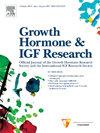PEG-rhGH治疗的剂量优化以改善儿童期起病生长衰竭的生长结局。
IF 1.6
4区 医学
Q4 CELL BIOLOGY
引用次数: 0
摘要
背景:本研究评估了优化PEG-rhGH剂量对由生长激素缺乏症(GHD)或非GHD原因导致的儿童性生长衰竭的青春期前和青春期儿童的疗效和安全性。方法:本研究采用回顾性(n = 144)和前瞻性(n = 14)相结合的设计来检查PEG-rhGH给药策略的影响。共有158名儿童参加了这项研究,其中130名在完成至少一年的随访后被纳入分析。参与者被分为青春期前组和青春期组。根据生长反应和IGF-1水平进行PEG-rhGH剂量滴定治疗。该研究的主要目的是评估个体化PEG-rhGH剂量的影响,包括基于临床的目标身高速度和IGF-1滴定,对GHD儿童和非GHD儿童的身高速度,按青春期分层。结果测量包括身高、体重、BMI和不良事件的变化。数据采用SPSS 25.0进行分析。结果:青春期前儿童身高增长明显高于青春期后儿童(9.75 cm比9.01 cm, p = 0.0159)。在两组中均观察到对生长速度的剂量依赖效应。发育期组的生长速率(GV)由≤0.200 mg/kg/周时的0.80±0.20 cm/年增加到≥0.220 mg/kg/周时的0.99±0.38 cm/年(p = 0.017)。同样,在青春期前组,GV从最低剂量的0.87±0.23 cm/年增加到最高剂量的1.10±0.24 cm/年(p = 0.048)。这些发现证实了剂量-反应关系,特别是在剂量超过0.200 mg/kg/周时。结论:PEG-rhGH治疗在促进青春期前儿童身高增长方面比青春期青少年更有效。在两组中都观察到明显的剂量依赖效应,强调了个体化给药对最佳生长结果的重要性。本文章由计算机程序翻译,如有差异,请以英文原文为准。
Dose optimization of PEG-rhGH therapy to improve growth outcomes of childhood-onset growth failure
Background
This study evaluates the efficacy and safety of optimized PEG-rhGH dosing in pre-pubertal and pubertal children with Childhood-Onset Growth Failure due to growth hormone deficiency (GHD) or non-GHD causes.
Methods
This study employed a combined retrospective (n = 144) and prospective (n = 14) design to examine the PEG-rhGH dosing strategies' impact. A total of 158 children were enrolled in the study, of whom 130 were included in the analysis after completing a minimum of one year of follow-up. Participants were stratified into pre-pubertal and pubertal groups. PEG-rhGH therapy with dose titration was administered based on growth response and IGF-1 level. The primary goal of the study was to evaluate the effect of individualized PEG-rhGH dosing, including clinically-based target height velocity and IGF-1 titration, on height velocity in children with GHD and non-GHD small children, stratified by puberty. Outcome measures included change in height, weight, BMI, and adverse events. Data were analyzed with SPSS 25.0.
Results
Pre-pubertal children exhibited a significantly greater height increase compared to pubertal adolescents (9.75 cm vs. 9.01 cm, p = 0.0159). A dose-dependent effect on growth velocity was observed in both groups. In the pubertal group, growth velocity (GV) increased from 0.80 ± 0.20 cm/year at doses ≤0.200 mg/kg/week to 0.99 ± 0.38 cm/year at doses ≥0.220 mg/kg/week (p = 0.017). Similarly, in the pre-pubertal group, GV increased from 0.87 ± 0.23 cm/year at the lowest dose to 1.10 ± 0.24 cm/year at the highest dose (p = 0.048). These findings confirm a dose-response relationship, particularly at doses exceeding 0.200 mg/kg/week.
Conclusions
PEG-rhGH therapy was more effective in promoting height growth in pre-pubertal children compared to pubertal adolescents. A clear dose-dependent effect was observed in both groups, emphasizing the importance of individualized dosing for optimal growth outcomes.
求助全文
通过发布文献求助,成功后即可免费获取论文全文。
去求助
来源期刊

Growth Hormone & Igf Research
医学-内分泌学与代谢
CiteScore
3.30
自引率
0.00%
发文量
38
审稿时长
57 days
期刊介绍:
Growth Hormone & IGF Research is a forum for research on the regulation of growth and metabolism in humans, animals, tissues and cells. It publishes articles on all aspects of growth-promoting and growth-inhibiting hormones and factors, with particular emphasis on insulin-like growth factors (IGFs) and growth hormone. This reflects the increasing importance of growth hormone and IGFs in clinical medicine and in the treatment of diseases.
 求助内容:
求助内容: 应助结果提醒方式:
应助结果提醒方式:


